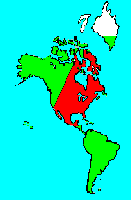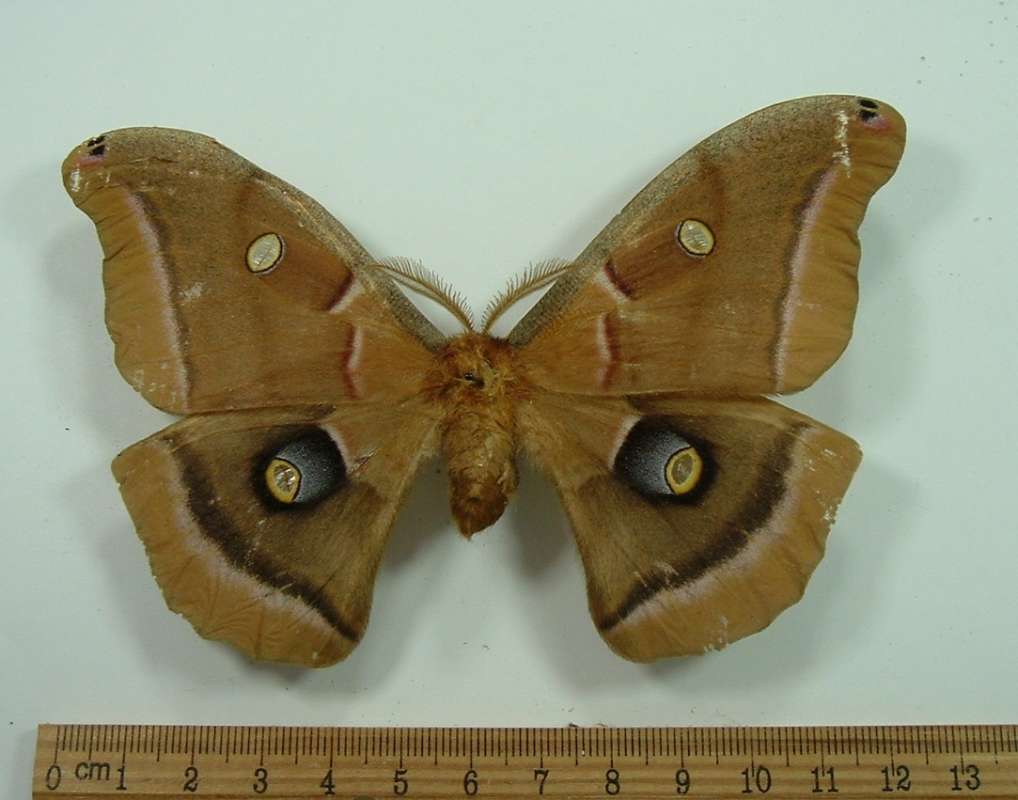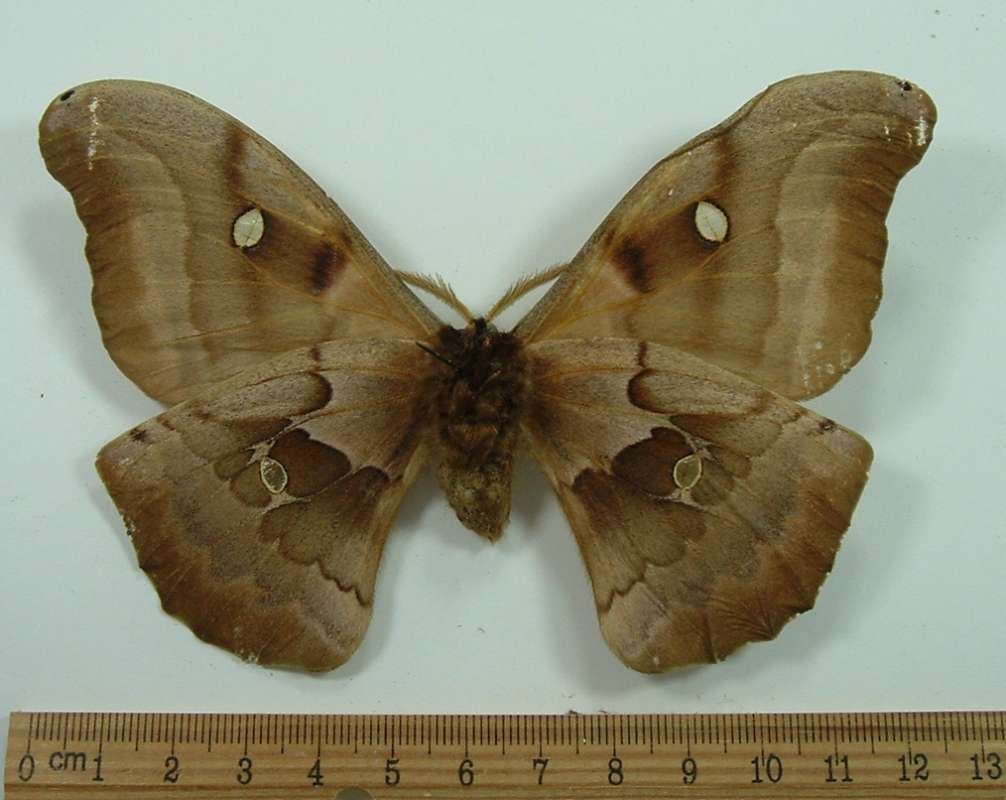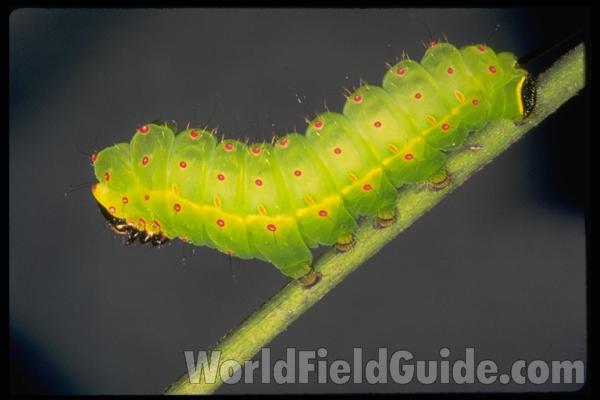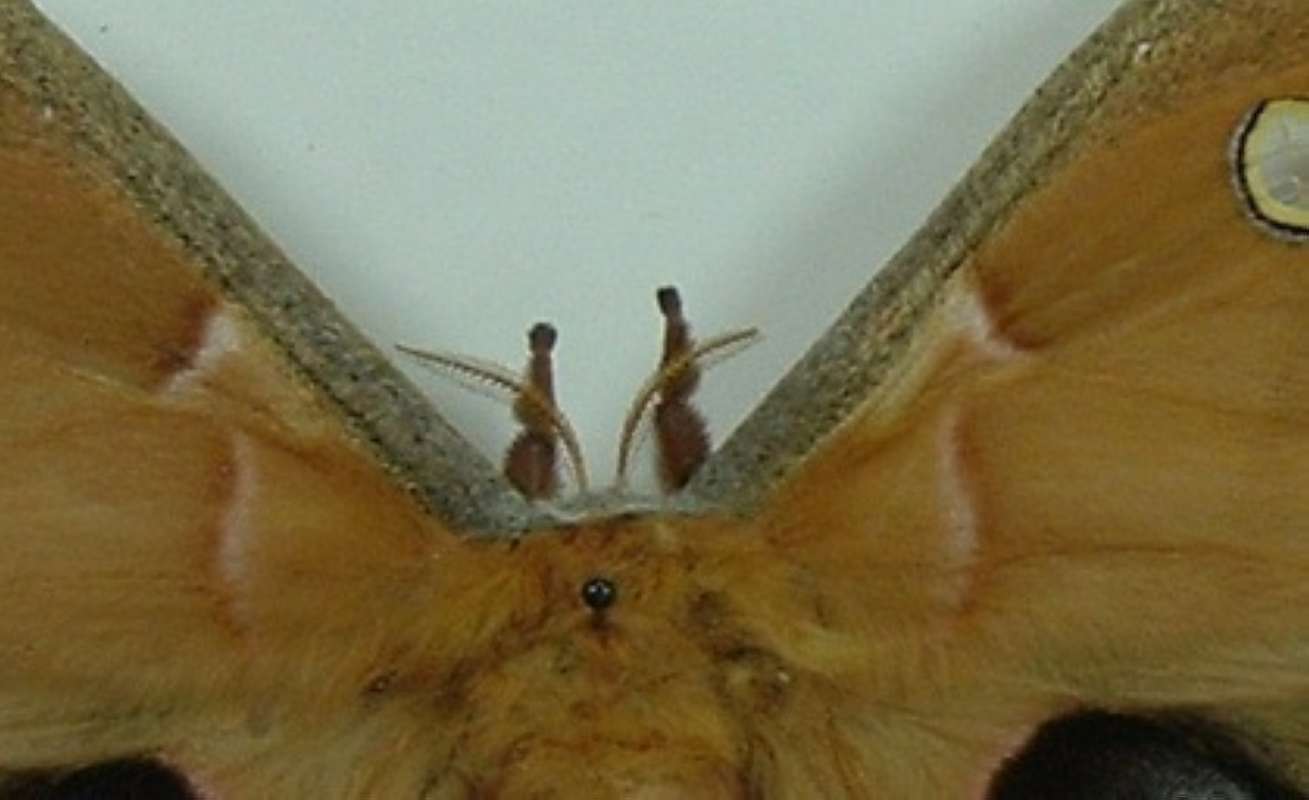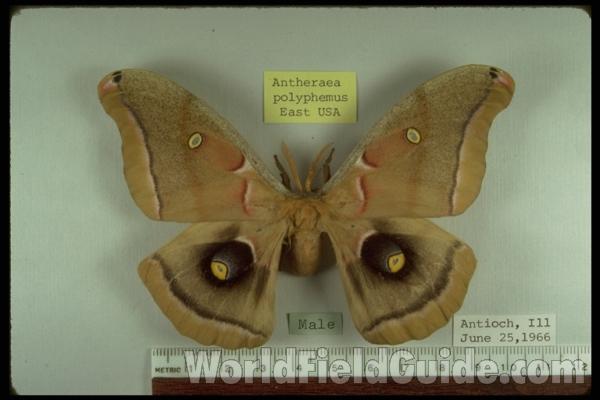SPECIES INFO
Polyphemus Moth (Antheraea polyphemus) is found from eastern Canada, west to Colorado and south (rarely) to Oaxaca, Mexico. Although the different environments create moths with slightly different color hues, they basically all have the same appearance.
If one looks at genetic differences as the means to separate species, then one can view the polyphemus moth in a different light. In general Saturnid female moths do not fly very far. In fact, they usually copulate on their original plant, and only fly after depositing many eggs. It would seem that the genetic design to survive from the north eastern United States to the great plains, Montana, Arizona, and other places would be unique to those areas. The need to change design or the method of reproduction would not be as pressing as a species expands as the need to cope with plant changes, environmental changes, and resistance to various species of parasitic wasps. Therefore, we show here specimens from numerous places.The New World genera Antheraea and Metosamia have been combined into the genus Antheraea. However, some authors are now referring to the New World members of this genus as subgenus Telea to the genus Antheraea. At any rate, some contend that there are three species in the group (godmani, montezuma, and polyphemus). Others raise polyphemus ssp oculea and polyphemus mexicanus to full species.
To help organize this complex genus and all its species in the Oriental area, we have named the New World Antheraea herein as Antheraea(Telea).
Saturnid moth group of eastern and central United States has three large species (luna, cecropia, and polyphemus) that are often fluttering around lights at night. Mounted Saturnid moth specimens fade if placed in light. Consequently collectors usually protect them from sunlight.
he Automris and Hemileuca genera belong here also.
Saturnid moths (family Saturnidae)are the giants of the moth world. They are usually characterized by their unique feather-like antennae. Males usually have larger antennae used to locate the females. Many species have transparent eye spots on their wings.
Typically, the males find the females upon emergence and copulate immediately. The United States government has frequently researched the sensing mechanism that permits the males to find the females in hopes of finding a military application.
Butterflies and Moths (Order Lepidoptera) are a group of insects with four large wings. They go through various life cycles including eggs, caterpillar (larvae), pupae, and adult. Most butterflies and moths feed as adults, but primarily do most of their growing in the larval or caterpillar stage. Also, most species are restricted to feeding as caterpillars upon a unique set of plants. In this pairing of insects to plants, there arises a unique plant population control system. When one plant species becomes too common, specific pests to that species also become more common and thus prevent the further spreading of that particular plant species.
Although most people think of the Lepidoptera as two different groups: butterflies and moths, technically, the concept is not valid.
Some families, such as Silk Moths (Saturnidae) and Hawk Moths (Sphingidae), are clearly moths. Other families, such as Swallowtail Butterflies (Papilionidae), are clearly butterflies, However, several families exhibit characteristics that appear to be neither moths nor butterflies. For example: the Castnia Moths of South America are frequently placed in the Skipper Family (Hesperidae). The Sunset Moths (Uranidae) have long narrow antennae and fly during the day.
The Saturnidae (Silk Moths) and Papilionidae (Swallowtails) are two Lepidoptera families that have been very carefully researched as to species and subspecies. The current thinking is that if the male genitalia are alike, then the two specimens belong to the same species. As an amateur, your editor disagrees with this premise. If the genitalia are different, then no doubt two species are involved. However, if the genitalia are alike, it only proves that the genitalia are alike.
Consider Papilio multicaudata which is found in southern Canada at higher altitudes. Papilio multicaudata is found south through the Rocky Mountains as far south as Mexico City, and recently as far south as Guatemala. With different food plants, different soil types, different climates, and different seasonal patterns, it is hard to believe that this complex is all one species.
Consider capturing 100 living individuals at any life stage in Guatemala and then carrying them north to southern Canada. Would these individuals survive through several generations. If they would not survive, then this author would conclude that two different species are involved!
In the Saturnidae consider Eacles imperialis subspecies pini. This life form feeds on pines. Is not this sufficient to justify a full species status?
Note: Numerous museums and biologists have loaned specimens to be photographed for this project.
Insects (Class Insecta) are the most successful animals on Earth if success is measured by the number of species or the total number of living organisms. This class contains more than a million species, of which North America has approximately 100,000. (Recent estimates place the number of worldwide species at four to six million.)
Insects have an exoskeleton. The body is divided into three parts. The foremost part, the head, usually bears two antennae. The middle part, the thorax, has six legs and usually four wings. The last part, the abdomen, is used for breathing and reproduction.
Although different taxonomists divide the insects differently, about thirty-five different orders are included in most of the systems.
The following abbreviated list identifies some common orders of the many different orders of insects discussed herein:
Odonata: - Dragon and Damsel Flies
Orthoptera: - Grasshoppers and Mantids
Homoptera: - Cicadas and Misc. Hoppers
Diptera: - Flies and Mosquitoes
Hymenoptera: - Ants, Wasps, and Bees
Lepidoptera: - Butterflies and Moths
Coleoptera: - Beetles
Jointed Legged Animals (Phylum Arthropoda) make up the largest phylum. There are probably more than one million different species of arthropods known to science. It is also the most successful animal phylum in terms of the total number of living organisms.
Butterflies, beetles, grasshoppers, various insects, spiders, and crabs are well-known arthropods.
The phylum is usually broken into the following five main classes:
Arachnida: - Spiders and Scorpions
Crustacea: - Crabs and Crayfish
Chilopoda: - Centipedes
Diplopoda: - Millipedes
Insecta: - Insects
There are several other "rare" classes in the arthropods that should be mentioned. A more formal list is as follows:
Sub Phylum Chelicerata
C. Arachnida: - Spiders and scorpions
C. Pycnogonida: - Sea spiders (500 species)
C. Merostomata: - Mostly fossil species
Sub Phylum Mandibulata
C. Crustacea: - Crabs and crayfish
Myriapod Group
C. Chilopoda: - Centipedes
C. Diplopoda: - Millipedes
C. Pauropoda: - Tiny millipede-like
C. Symphyla: - Garden centipedes
Insect Group
C. Insecta: - Insects
The above list does not include some extinct classes of Arthropods such as the Trilobites.
Animal Kingdom contains numerous organisms that feed on other animals or plants. Included in the animal kingdom are the lower marine invertebrates such as sponges and corals, the jointed legged animals such as insects and spiders, and the backboned animals such as fish, amphibians, reptiles, birds, and mammals.
